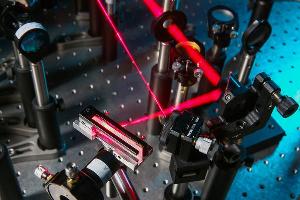Mar 20 2014
Molecular interactions occurring at the interface between water and other substances can have an influence on the functioning of our bodies. EPFL researchers have been able to observe these interactions through the use of highly innovative optical techniques.
 Lasers and complex optic techniques are used to observe molecular interactions at water/oil interface.
Lasers and complex optic techniques are used to observe molecular interactions at water/oil interface.
Sodium chloride or NaCl – also known as table salt, is part of our daily diet. Potassium chloride, or KCl, can also be consumed, although its flavor is decidedly bitter. In contrast, potassium thiocyanate, or KSCN, although closely related chemically to the first two varieties, is deadly when ingested in even very small doses. This is an example of the different effects, called specific ion effects, which may result at the macroscopic scale from mechanisms acting on the nanoscale. The work of Sylvie Roke and her team at EPFL’s Laboratory of fundamental BioPhotonics (LBP) offers a new understanding of these phenomena and their influence on the functioning of the human body. They have been the subject of a recent article in the Journal of the American Chemical Society (JACS).
Specialized in understanding complex biological systems on the nanoscale, the researchers have revealed the physicochemical interactions between large amphiphilic ions – atoms or molecules that have lost or gained an electron – and the surfaces with which they come into contact. These interactions influence numerous processes, such as the formation of the cell membrane, the role of proteins and peptides, and even the activity of enzymes.
Whether they are anions or a cations
Through innovative optical techniques, the researchers were able to study with precision the behavior of amphiphilic ions – that is to say, composed of one part hydrophilic and another part hydrophobic. It has been assumed that these compounds ensure the stability of the interface between two liquids by dipping their “head” in the water phase and “tail” in the oily phase.
The Roke lab found however that these amphiphilic units adopt very different structures depending on whether they are anions or cations. That is to say, the anionic amhiphiles (that have gained one electron) align interfacial water molecules and do not mix with the oil phase, while the cationic amphiphiles destroy water alignment and mix with the oil phase, resulting in two entirely different interface structures and stabilization mechanisms. Thus, even for the case of interface stabilization specific ion effects play an important role.